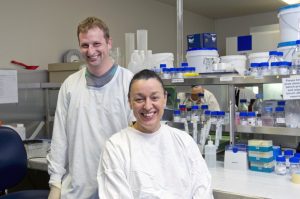 Shake It Up Australia Foundation is delighted to announce new funding for world’s best research being conducted at Neuroscience Research Australia (NeuRA). The twelve month research grant funded in partnership with The Michael J. Fox Foundation for Parkinson’s Research will enable Professor Glenda Halliday and Dr Nicolas Dzamko to undertake research targeted at determining the effectiveness of LRRK2 blocking drugs. Mutations in the LRRK2 gene are a common cause of Parkinson’s disease.
Shake It Up Australia Foundation is delighted to announce new funding for world’s best research being conducted at Neuroscience Research Australia (NeuRA). The twelve month research grant funded in partnership with The Michael J. Fox Foundation for Parkinson’s Research will enable Professor Glenda Halliday and Dr Nicolas Dzamko to undertake research targeted at determining the effectiveness of LRRK2 blocking drugs. Mutations in the LRRK2 gene are a common cause of Parkinson’s disease.
People born with certain genetic mutations in a protein known as Leucine-Rich Repeat Kinase 2 (abbreviated to LRRK2) are at a much greater risk of developing Parkinson’s disease. The most common inherited mutation increases the activity of the LRRK2 protein. It is thought that this increased activity may contribute to the onset of Parkinson’s disease. A number of drugs capable of blocking the activity of LRRK2, are therefore being developed by both academia and the pharmaceutical industry as potential Parkinson’s disease therapeutics.
Hand in hand with generating compounds that can act as LRRK2 blocking drugs is a need to generate reliable assays to tell you that the drugs are actually working. This has been a major challenge in progressing work on LRRK2 blocking drugs as we still don’t know for sure what LRRK2 actually does. Some progress has been made however, with Dr Nicolas Dzamko and colleagues discovering a way to tell if LRRK2 blocking drugs were indeed entering cells and blocking LRRK2. The challenge is now to refine the assay, originally developed in test tubes, for use on potential human patients.
This work will be performed at Neuroscience Research Australia (NeuRA) and is jointly funded by The Michael J. Fox Foundation for Parkinson’s Research and Shake It Up Australia Foundation. It involves collecting blood samples from patients with Parkinson’s disease and treating the blood with prototype LRRK2 blocking drugs. A technique known as flow cytometry will be optimised and used to measure LRRK2 in the blood samples treated with or without LRRK2 blocking drugs. This technique should enable doctors to determine if LRRK2 blocking drugs are working. This is essential to know before one can test if the drugs are having a therapeutic effect on Parkinson’s disease in any potential future clinical trials.


